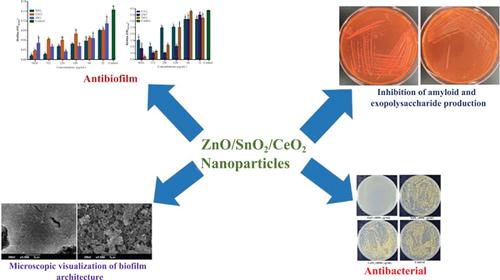Recent Patents on Nanotechnology ( IF 2 ) Pub Date : 2020-08-31 , DOI: 10.2174/1872210514666200313121953 Fazlurrahman Khan 1 , Jang-Won Lee 2 , Dung N T Pham 2 , Mohammad M Khan 3 , Seul-Ki Park 1 , Il-Shik Shin 4 , Young-Mog Kim 1, 2

|
Background: The ability to form biofilm and produce several virulence factors has caused numerous human pathogens to become tremendously resistant towards traditional antibiotic treatments, thus, new alternative strategies are urgently in demand. One of the strategies that have recently been developed involves the application of metallic Nanoparticles (NPs). Up to the present, promising results in terms of antimicrobial and antibiofilm activities have been observed in a wide range of metal NPs.
Methods: The present study has selected three metal oxides such as ZnO, SnO2 and CeO2 NPs to comparatively investigate their antibiofilm and antibacterial properties against two Gram-positive human pathogens, which are Listeria monocytogenes and Staphylococcus aureus.
Results: The anti-biofilm activities of ZnO, SnO2 and CeO2 NPs against S. aureus and L. monocytogenes were assayed by crystal violet staining and confirmed by microscopic visualization using SEM. The synthesis of amyloid protein by S. aureus and exopolysaccharide by L. monocytogenes in the presence of ZnO, SnO2 and CeO2 NPs was evaluated by Congo red assay.
Discussion: Results have shown that ZnO, SnO2 and CeO2 NPs effectively inhibited biofilm formation of both L. monocytogenes and S. aureus. The microscopic analysis also confirmed the antibiofilm activity of these NPs. It was also found that only ZnO NPs inhibited cell growth as well as the production of amyloid protein in S. aureus.
Conclusion: Overall, these results indicated that ZnO, SnO2 and CeO2 NPs can be considered as potential agents for treating the infections caused by L. monocytogenes and S. aureus, especially those associated with biofilm formation. Based on the present study, further studies are required to understand their mechanisms at both phenotypic and molecular levels, as well as their in vivo cytotoxicity, thereby enabling the applications of these metal oxide NPs in biomedical fields and food industry.
中文翻译:

ZnO、SnO2 和 CeO2 纳米颗粒对革兰氏阳性生物膜形成病原菌的抗生物膜作用
背景:形成生物膜和产生多种毒力因子的能力已导致许多人类病原体对传统抗生素治疗产生极大的耐药性,因此迫切需要新的替代策略。最近开发的策略之一涉及金属纳米颗粒 (NP) 的应用。到目前为止,已经在广泛的金属纳米颗粒中观察到了抗菌和抗生物膜活性方面的有希望的结果。
方法:本研究选择了三种金属氧化物,如 ZnO、SnO2 和 CeO2 NPs,比较它们对两种革兰氏阳性人类病原体(单核细胞增生李斯特菌和金黄色葡萄球菌)的抗生物膜和抗菌性能。
结 在 ZnO、SnO2 和 CeO2 NPs 存在下,金黄色葡萄球菌合成淀粉样蛋白,单核细胞增生李斯特菌合成胞外多糖,通过刚果红试验进行评估。
讨论:结果表明,ZnO、SnO2 和 CeO2 NPs 能有效抑制单核细胞增生李斯特菌和金黄色葡萄球菌的生物膜形成。显微分析也证实了这些纳米颗粒的抗生物膜活性。还发现只有 ZnO NPs 抑制细胞生长以及金黄色葡萄球菌中淀粉样蛋白的产生。
结论:总的来说,这些结果表明 ZnO、SnO2 和 CeO2 NPs 可以被认为是治疗由单核细胞增生李斯特菌和金黄色葡萄球菌引起的感染,尤其是与生物膜形成相关的感染的潜在药物。基于目前的研究,需要进一步研究以在表型和分子水平上了解它们的机制,以及它们的体内细胞毒性,从而使这些金属氧化物 NPs 在生物医学领域和食品工业中的应用成为可能。



























 京公网安备 11010802027423号
京公网安备 11010802027423号